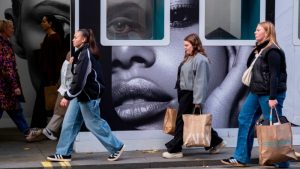Me, my mother and making scents of Myanmar

There are brands that emerge like unicorns from business plans hastily concocted on the backs of envelopes, and there are those that take a little bit longer. It’s been nine years since I first Skyped esteemed perfumer Frank Voelkl and persuaded him to create a fragrance for the new brand I wanted to launch, inspired by Myanmar and my mother’s history.
German-born, New York-based Voelkl is the perfumer behind such scents as Le Labo’s phenomenally successful Santal 33. He has become the defining olfactive creator for a particular generation – urban-oriented but wanting something different, maybe even a little cultish. He appeals to niche perfumers like Ellis Brooklyn, for which he created Florist; Phlur, for which he made the unisex Mood Ring and Father Figure; and Glossier, for which he co-created the runaway hit You with Dora Bagriche. He created Hugo Reversed for Hugo Boss, and Bamboo for Gucci, in 2015. Santal 33 remains the bar-setter. Its intriguing-yet-familiar sharp violet and rugged-yet-creamy sandalwood is so popular among certain hipster-professionals that in 2022 it made the number two slot in WWD’s 100 Greatest Fragrances of All Time, just behind Chanel No 5.
Not that any of this was on my radar 30 years ago, when I first visited Myanmar, aged 26. As I stepped off the Biman Bangladesh Airlines flight into Yangon I burst into tears, overwhelmed by being in the country of my mother’s birth for the first time.

My mother, Maureen Rossiter, was born in Myanmar in 1933. But, orphaned during the second world war, she left Rangoon, as it was called then, on the SS Cheshire in April 1947. She travelled a few days before her 14th birthday, flying on to Dublin and her new home with her grandmother and her only sister, Patricia. Her Irish father, a serving officer in the Burma Frontier Force, had led one of the last groups of Anglo-Burmese through unmapped jungles to safety in India in order to escape the invading Japanese, but had later died in Calcutta. Her Burmese mother, a beautiful village girl who rolled cheroots for a living prior to marrying my grandfather, had died in relative poverty. My mother was left – with two other Anglo-Burmese girls known as Lucy and Mary – with Italian nuns in a convent boarding school in the cooler hills of Kalaw.



After the war, Maureen’s surviving Burmese family trekked over to Kalaw to try and bring her home, but were turned away. Unbeknownst to them, my mother had received a package from the Red Cross of undelivered letters, sent from Ireland by her grandmother and Patricia, who had written constantly throughout the war. The lure of Dublin and having a sister of her own was something she couldn’t turn her back on.
When I first visited in 1994 (I’ve been back several times since), it was under the strict Orwellian leadership of the Tatmadaw, the military government. It was hard for tourists to travel freely, but my mother had introduced me to Mary, her schoolfriend from her convent school days; so along with Mary’s husband, a retired Burmese Army colonel with privileged access to petrol, we set off to find my mother’s relatives.


I’ve experienced a lot of love in my life, but nothing quite like the outpouring of affection from my cousins, aunts and uncles. They had never expected to see anyone from my mother’s family again, and they had pined for her. There were tears, gifts, photographs and stories, all slowly translated for my benefit.
Back in London something clicked. The dusty roads, the trails of jasmine flowers given as temple offerings, the sunsets at Shwedagon Pagoda with its gold leaf and green neon lights, the smiling faces covered in powdery pale-yellow thanaka, the betel-nut smudges on the pale-green colonial-era buildings, the shiny black lacquer offering bowls and bright plastic teashop stools were now a part of me. Together, they felt like a special kind of protective glow. I wanted to translate all that magic into… something.

In the years that followed, I nurtured a career as a beauty journalist, and began to think the answer to this alchemy could be found in a perfume. In 2015, Fabrice Penot, co-founder of Le Labo, introduced me to Frank Voelkl.
Quietly spoken, Voelkl listened intently, rather than banging on about “seduction”, which was what all perfumers liked to do at the time. Over that first Skype call, we talked about the way he liked to work with natural ingredients, but combine them with single-note synthetic molecules, which help make a fragrance perform longer, and we discussed the ingredients I loved.

I was obsessed with a particular white flower I’d seen in Myanmar, the petals of which were threaded together in garlands before being draped over statues of Buddhas at Shwedagon Pagoda; I knew I also wanted jasmine, because my grandmother had often worn it in her elegantly coiled hair. But I also wanted the green of cut grass, and the sharpness of the sunlight when it hits the dust on the bumpy roads from Yangon out to Bagan, to Kalaw, to Mandalay.
Voelkl also asked me what colours I envisaged, and our conversation turned to the small gold-leaf books with their bright-pink bindings used to make temple offerings, or the neatly pressed shirts that everyone in Myanmar wears, no matter how rich or poor. This inspired me to send him a little package of sandalwood prayer beads, pictures of temples, a little lacquer box, and the memoir my mother had written about her childhood, A World Overturned.

Crucially, Voelkl made sure to leave our new creation feeling very slightly unfinished, and not like a fine fragrance. I loved this. “A lot of times when we work on fragrances, we tend to polish it off, removing anything that might set itself too far apart,” he says. “And it’s a very dangerous thing, because you want to have harmony, and you need balance – but that doesn’t mean there shouldn’t be things that are, you know, a little bit ‘off’. These are the things that can trigger something emotionally, that mean each time you go back to the fragrance you discover a new facet.”
It only took us about three iterations to get my perfume where we wanted it to be – it turns out you don’t need thousands of versions to find the right one. Although, as Voelkl reminds me, that doesn’t mean that for every back and forth there weren’t about 10 samples also being carefully considered in the DSM-Firmenich laboratory.


I love the final creation. To the middle of jasmine, freesia and iris, there is a dry down of cedarwood, sandalwood, musk and ambergris, and a sparkling top of bergamot, green leaves, some cardamom and neroli. It is as much an olfactory memoir of my mother and the country of her childhood as it is a love story in its own right.
Some years later, I had the time to properly develop it, working with a design team on packaging and the logo – inspired by the faces I saw in Myanmar with thanaka on them. We paused only when the 2021 military takeover thrust the country into darkness, overthrowing the fragile democracy. I turned my attention to fundraising for various Myanmar charities, but came to see that, in its own small way, the fragrance was another way to shine a spotlight on this very special country.
All that was missing was the name. It came to me, as these things do, in a very unglamorous way – while stretching on a yoga ball: “Catch me if I fall,” I shouted to my boyfriend. At that moment I realised it was what I had been looking for in the past few years – years that had been particularly tumultuous and very tough for me. It was what I realised I had had from my late parents, now very much missed. It was the love I felt from that faraway country, going through such a terrible time on its own. And just like the fragrance that had been lying in the drawer all those years, it had been there for me all that time.
La Pyae Apothecary, Catch Me If I Fall, £185 for 50ml EDP, lapyae.com
11 more fragrances inspired by real people. By Inès Cross

Guerlain Eau de Cologne Impériale (1853)
Neroli, lemon and bergamot are combined in a fragrance concocted for Empress Eugénie (wife to Napoleon III) to treat her migraines. £97 for 100ml

Annick Goutal Petite Chérie (1998)
This “caress” of rose and pear wrapped in vanilla and musk was created for Goutal’s daughter, Camille, when she was 23. €205 for 100ml

Serge Lutens La Fille de Berlin (2013)
A rich, velvety fragrance born of red roses and pepper, inspired by the glamour of 20th-century actress and singer Marlene Dietrich. £191 for 100ml

Bella Freud Psychoanalysis (2017)
Neroli and petitgrain flirt with leather and tobacco in an homage to Austrian neurologist Sigmund Freud, who was said to have smoked 20 cigars a day. £165 for 100ml

Kingdom Scotland Albaura (2019)
Cassis bud heart, Arctic poppy and rock moss pay tribute to Scottish botanist and Arctic explorer Isobel Wylie Hutchinson. £132 for 50ml

Vyrao Georgette (2021)
Featuring a Herkimer diamond crystal, this “elixir for self-love” contains rose oil, violet leaf, sandalwood and patchouli, and honours the grandmother of Vyrao’s founder. £135 for 50ml

Jouissance Parfums En Plein Air (2024)
One of three debut fragrances inspired by erotic writers of the 20th century, this bottle honours writer and critic Catherine Millet with bergamot, grapefruit and musk. £180 for 50ml

Thameen Bold as Love (2024)
Ginger, pineapple and patchouli meet smoky leather undertones in this potent cologne that captures the “raw and beastly” energy of Jimi Hendrix. $295 for 100ml

Fendi Casa Grande (2024)
A sultry mix of leather, cherry liquor and myrrh celebrates Fendi’s co-founder Adele Casagrande, who opened the maison’s first workshop in Rome almost a century ago. £270 for 100ml

Eau d’Italie Rosa Greta (2017)
A romantic concoction of Damascus rose, lychee and white tea which draws inspiration from Hollywood film star Greta Garbo’s Italian hideaway, Villa Cimbrone, on the Amalfi Coast. €165 for 100ml

Coty L’Aimant Parfum De Toilette (1927)
Translating to “the magnet” in English, this sweet, powdery scent features notes of peach, rose and jasmine, and is thought to be inspired by François Coty’s favourite mistress, Henriette Daude. £14.49 for 50ml; boots.com
#mother #making #scents #Myanmar





